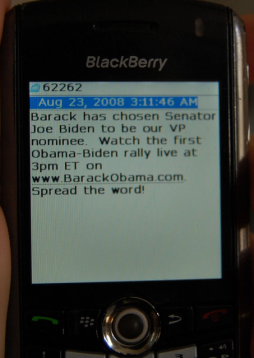The idea was clever: Promise political supporters first dibs of hard-hitting news delivered via SMS. Presidential candidate Barack Obama's much-anticipated vice-presidential pick was supposed to be sent to his supporters via text message and email first - notifying people who had signed up with the campaign before the media, before anyone else. The buzz was on, and even though numbers are not released by the campaign, it is estimated that the campaign has now a list of about 1 million mobiles numbers when more and more people signed up to be the first to know who the campaign had picked as VP.
But it did not quite work this way. Obama's campaign has been exemplary in the use of mobiles and there are many lessons to be learned for mobile social marketing campaigns (and our hats off to Scott Goldstein, one of the lead organizers for the Obama mobile team) but this one was a bit of a flop. The much-anticipated text message went out at 3 am United States Eastern Time -- two hours after CNN (i.e. old media) had confirmed the vice-presidential pick. Supporters received text messages anywhere between 3.02 am and 7 am in the morning -- and some estimated 5% never received anyting at all. By that time, news outlets the world over had reported CNN's scoop. Email messages also seemed to lag -- some were delivered immediately but many did not trundle in until much later.
That kind of volume of text messages takes time to deliver -- churning through an estimated 1 million numbers even with excellent gateways takes several minutes (Obama's vendor is Distributive Networks and its CEO was quoted as saying that it was about 15 min of clicking through the numbers). Text messages also have lag times in delivery - sometimes up to several hours, depending on carriers, gateways, and wether the recipient has the phone on and is in a decent reception area)
Text messages delivered at night are also not the best idea -- delivery can be delayed even further and waking up a supporter can backfire in terms of good will when the phone beeps in the middle of the night.
In short, the hype and expectation outstripped the technical capacities of the medium (large volumes of text messages take time to deliver in the current US mobile infrastructure); and the campaign waited too long to announce and was scooped, and then had to scramble in the middle of the night when delivery and good will are less assured. The fact that messages were delivered long after the news hit generated more ridicule than admiration for what has been othwerise and overall admirable mobile strategy.
Some have argued that the public relations generated alone by the VP announcement via text was worth the whole thing. Certainly, this was 'the most anticipated text message of the year,' as some commentators put it. And there is something said for PR--particularly for campaigns that focus on educating the public and generating awareness. However, for a political campaign every dollar spent in the end has to translate into votes--actually people pulling actual levers in actual voting booths.
So then the question, of course it, whether the acquisition of phone numbers was worth what ended up a PR fumble when the messages came in late. Getting something like a million numbers can be useful for turnout, especially if the demographic is younger and harder to reach through traditional get-out-the vote efforts. Of course, this depends entirely on the size of the mobile list and location of where supporters are located. The Wall Street Journal reported on a blog post in a reference that was later removed from the site (check the Google cache) that a campaign spokesperson had confirmed that 3 million people had signed up for the text message. A more widely-quoted set of mobile experts talked about a million sign-ups. Given that the Obama email list is about 5.5 million, we think that 3 million is a vast exaggeration and that even 1 million moble numbers may be too high an estimate Other than American Idol, Obama does have conceivably the largest mobile list of opt-ins in the country right now but we think it is probably just short of a million.
It is also reasonable to assume that most zip codes represented are in the safe Northeast and urban areas of the West Coast -- areas where getting out the vote is a lot less urgent than in battground states where every vote counts. GOTV via text message is an effective and inexpensive way to motivate voters to go to the polls, so the unerlying idea is a good one. But extracting safe states from the list leaves presumably (and yes, this is nothing but speculation) a list a lot less valuable for GOTV purposes.
This is not to say at all that we do not apprreciate the experiment, the overall mobile innovations the campaign has shown, and the opening that this presents to social mobile marketing that has been overdue. But it also shows the existing limits of the medium and is a warning to be realistic of what it can deliver right now.
Photo courtesy Emma K.


Post new comment